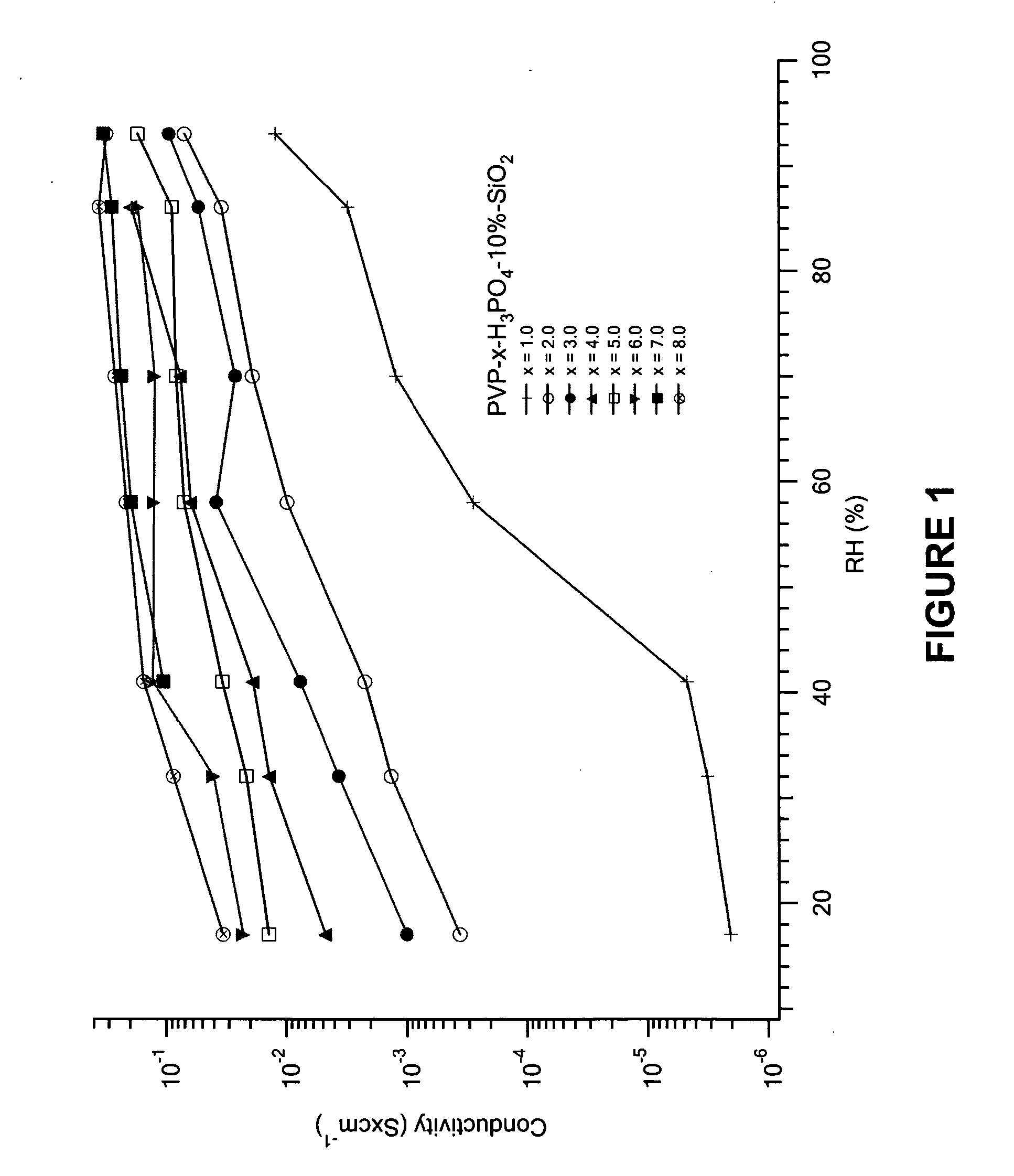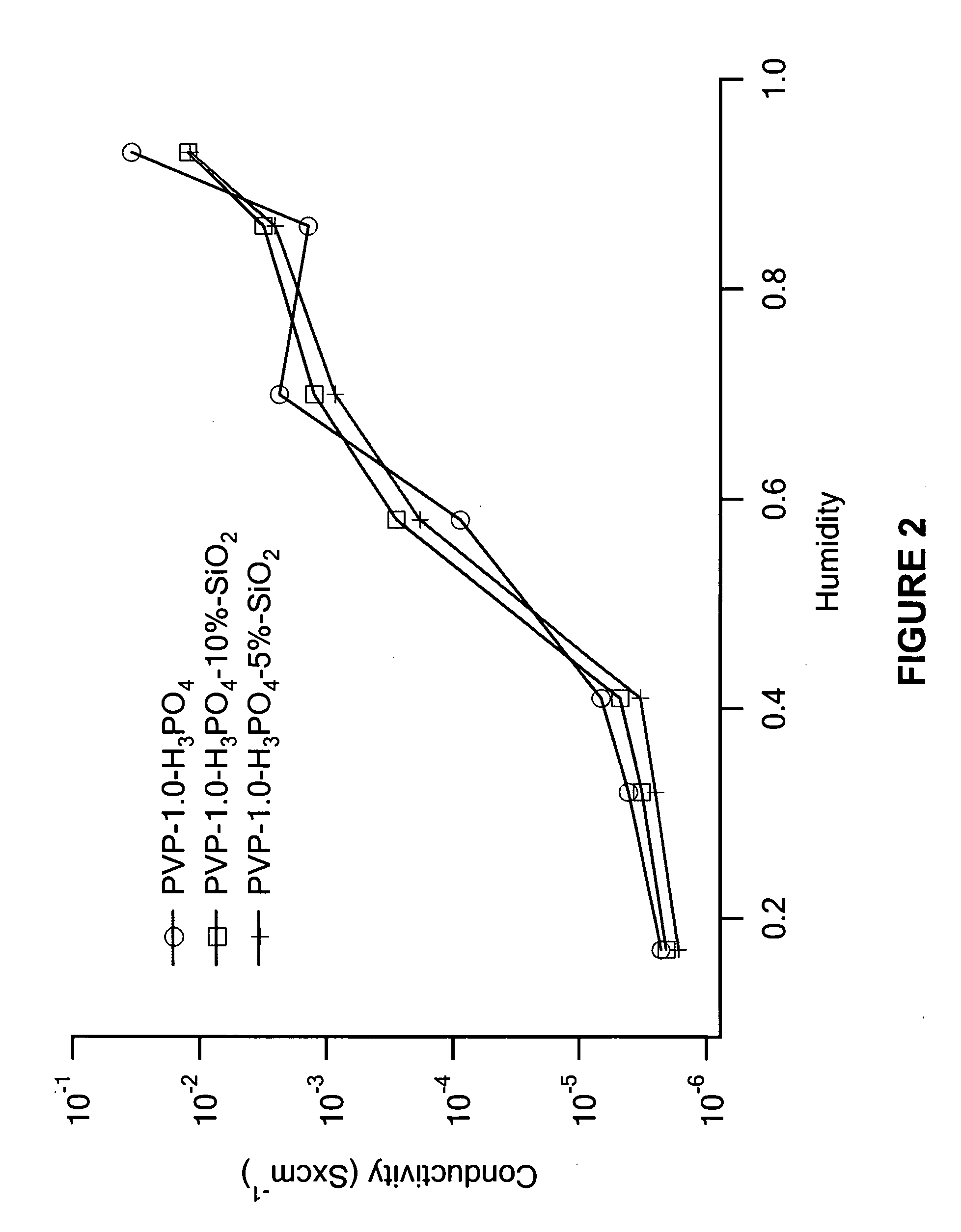Hydrophilic polymer-oxide-phosphoric acid compositions for proton conducting membranes
a proton conducting membrane and hydrophilic polymer technology, applied in the direction of transportation and packaging, non-aqueous electrolyte cells, electrochemical generators, etc., can solve the problems of affecting the commercialization of pefc, water can be problematic, and the availability of suitable membranes is not suitabl
- Summary
- Abstract
- Description
- Claims
- Application Information
AI Technical Summary
Benefits of technology
Problems solved by technology
Method used
Image
Examples
example 2
Proton Conductivity of the Hybrid Membranes
[0050] The proton conductivities of the membranes were measured using an HP impedance analyzer at room temperature as a function of humidity. The experimental results are shown in FIGS. 1-5. In FIG. 1, the proton conductivity of PVP-x-H3PO4-10%-SiO2 membranes increases with H3PO4 content and relativity humidity. It can be found that at lower phosphoric acid loading (x=1.0˜3.0), the proton conductivity is humidity sensitive. For example, in x=1.0, when humidity increases from 17% to 93%, the conductivity increases from 2×10−6 to 0.01, a magnitude of 104. At a higher acid content (x=4.0˜6.0), although conductivity still increases with acid loading, the increase is very limited. For example, the conductivity of the x=6.0 sample at 17% RH is 0.02 while at 93% it is 0.19. This results suggest that the hybrids with x>3.0 acid content are proper choices for proton conduction at elevated temperature, especially at 120˜150° C. where the membrane wo...
example 3
Thermal Properties of the Hybrids
[0054] The thermal stability and glass transition of the membranes were studied using TGA and DSC in a N2 atmosphere. FIG. 6 shows the TGA curves of PVP, H3PO4 and some hybrids. It can be found that PVP is thermally stable up to 400° C. Phosphoric acid, however, starts to lose weight from 50° C. Because it is very hygroscopic, the weight lost below 100+ C. is believed to cause by the release of water adsorbed in sample preparation. In about 200° C., phosphoric acid cross-links to form polyphosphoric acid, and keeps stable to 550° C., above which the material decomposes and has significant weight lost. The hybrid materials have a decomposition temperature at about 200° C., which is between that of PVP and phosphoric acid. It is interesting that the content of phosphoric acid has limited effect on the decomposition temperature. A possible reason is that phosphoric acid reacts with polymer and silica thoroughly and the material is well interpenetrated ...
PUM
| Property | Measurement | Unit |
|---|---|---|
| molar ratio | aaaaa | aaaaa |
| molar ratio | aaaaa | aaaaa |
| molar ratio | aaaaa | aaaaa |
Abstract
Description
Claims
Application Information
 Login to View More
Login to View More - R&D
- Intellectual Property
- Life Sciences
- Materials
- Tech Scout
- Unparalleled Data Quality
- Higher Quality Content
- 60% Fewer Hallucinations
Browse by: Latest US Patents, China's latest patents, Technical Efficacy Thesaurus, Application Domain, Technology Topic, Popular Technical Reports.
© 2025 PatSnap. All rights reserved.Legal|Privacy policy|Modern Slavery Act Transparency Statement|Sitemap|About US| Contact US: help@patsnap.com



